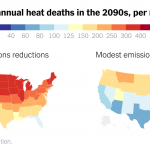Pre-pandemic, Europe’s green parties were on a roll. In France last summer, supporters hailed a “green wave” after regional polls handed the Europe Ecology party control of showcase cities such as Lyon, Strasbourg and Bordeaux. Austria’s Greens are the surprise junior partners in a conservative-led coalition government, delivering pioneering measures to curtail short-haul air travel. In the 27 EU member states, five governments now have Green members sitting at the cabinet table.
If ambitious net zero targets are to amount to more than earnest virtue signalling, this infiltration of the political mainstream is both overdue and necessary. And now comes the biggest test – and the greatest opportunity – of all. Consistently running a comfortable second in the polls to Angela Merkel’s Christian Democratic Union, and already governing in coalition in 11 states, Germany’s Greens are well-placed to form part of the country’s first “black-green” coalition after September’s federal elections. The CDU’s recent endorsement of the centrist Armin Laschet as its new leader suggests it sees such an alliance as a likely route to staying in power, as Ms Merkel steps down after 16 years in office. The Greens will decide this spring which of its two co-leaders should be its candidate for the top job: the media-savvy and charismatic Annalena Baerbock, or the equally ambitious moderniser Robert Habeck, talked up in some quarters as Germany’s Emmanuel Macron.
It is unlikely that either will end up succeeding Ms Merkel. Bolstered by the chancellor’s generally sure-footed handling of the pandemic, the CDU and its Bavarian sister party, the Christian Social Union, have a stable and significant lead in the polls. But a sizeable ministerial presence for the Greens in Berlin would send a powerful signal throughout Europe, as vital decisions are taken about post-pandemic investment. Ms Baerbock and Mr Habeck want to introduce a carbon tax, phase out coal production in Germany far faster, invest more in green technologies, quintuple the use of wind energy and discontinue the controversial Nord Stream 2 gas pipeline from Russia.
In a 2016 book entitled Who Dares, Begins, Mr Habeck argues that a modernised green politics can seize the initiative in a political landscape that no longer conforms to a conventional left-right model. Both he and Ms Baerbock have been working overtime to distance the party from past associations with pacifism, and a sometimes censorious approach that earned it the nickname of Verbotspartei (prohibition party). An overtly capitalist, pro-Nato stance will not be to the taste of some of its hardcore supporters, but with poll ratings stable at around 20%, the realo (pragmatic) wing of the party is in charge.
Given the electoral stagnation of the once-formidable Social Democrats, if they continue to play their cards skilfully, die Grünen have a good chance of becoming the number one progressive party in Germany. A note of caution should be sounded, however, as the party attempts, in the words of Mr Habeck, to “become the new playmakers” in Europe’s most powerful country. Green supporters in Germany remain largely middle class, city-based and youthful – much the same demographic that voted for the Europe Ecology party in French cities last year. If voters outside the prosperous cities continue to worry about the impact of a green transformation on their living standards and jobs, the journey to net zero will be both slower and painfully divisive. Addressing that mistrust, particularly in the east, will be a priority for the next German government, whatever its colour.

Average Rating